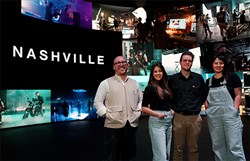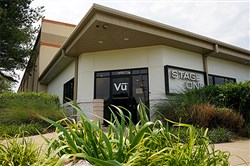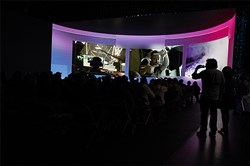VOL. 47 | NO. 23 | Friday, June 2, 2023
Off-the-wall possibilities
By Tom Wood
Where would you like to go? Whether it’s the rainforests of Brazil, the splendor of the Smoky Mountains, the sunny beaches of the Gulf Coast, a high-speed car chase or the farthest reaches of outer space, you’re mere seconds away at Vu Studio Nashville.
At a recent demonstration of its state-of-the-art virtual technology for Nashville’s film and entertainment community, visitors were treated to a seamless shift from cloudy skies to torrential downpours, from beaches to grasslands to arid deserts to snow-capped mountains.
Welcome to the world of virtual production, Nashville, where you’re limited only by imagination as to what can be envisioned on the studio’s massive J-shaped LED wall.
Megan Hill, general manager of the company’s Nashville studio – one of four, along with Tampa, Orlando and Las Vegas – describes Vu’s approach as “kind of like the showrooms to show that it can be done, how you do it, and then we go out into the world.”
The Nashville soundstage opened in February 2022, and most of its business focuses on commercial work, music videos and live immersive events, which makes sense, being in Music City, as artists such as Carrie Underwood have used the facility.
But there have been forays into sports productions, including a recent segment for NASCAR featuring veteran drivers Ricky Cravens and Kurt Busch and the story of the finish of the 2003 race at Darlington. As they are speaking, the thrilling race plays on the wall behind them. (To watch the segment, go to YouTube and search “NASCAR greatest finish.”)
“They brought in a lot of drivers and commentators and did really amplified interviews in our space. The drivers and the commentators were able to watch playback of races and crashes and finishes,” Hill says.
“They were watching and talking about what they were thinking while they were watching it and they were crying. It was really emotional.”

Vu Studio’s Tanner Grandstaff, account executive, Magan Hill, general manager, Grant Sutton, ICVFX supervisor, and Reika Kadlec, office manager.
-- Photo By Michelle Morrow |The LedgerHill’s goal is to continue to grow the side of the business that contributes to film and television projects. “It’s been exciting and fun. We are doing some film work and some episodic stuff but not as much (as commercials),” says Hill, a Centennial High School and Trevecca Nazarene University graduate. “But we think that’s maybe next for us. We’re just evolving with the times.”
It starts with the wall
At the heart of the 16,000-square-foot soundstage is the curved LED volume wall. Much like a top-of-the line, curved television screen – except that it is 123 feet wide and 20 feet tall with 12,600 x 2,016 total pixels – the visual effects are stunning and spectacular.
The use of massive LED walls is quickly replacing green screen technology, a boon for the film industry since it projects realistic images that an actor can see and react to, rather than standing in front of a blank green screen and being told that they’re being chased or whatever. In many instances, it eliminates the need for expensive on-location shoots.
A number of recent TV and film projects have used the technology, including The Mandalorian, House of the Dragon and Ant Man: Quantumania.
But it’s not just the big-budget, effects-heavy movies that make use of such a wall. For example, Vu’s Las Vegas studio is where Nicholas Cage filmed much of the upcoming movie Sympathy for the Devil, out July 28.
“Half of their movie script was in a car, and those types of scenes are…very easy to do in here and it makes everything much smoother,” Hill says.
“I think this is the beginning. It’s moving from green screen to LED wall, you know. Then it went to projection on a wall, like on a white wall, then it moved to LED screens. So I think this is just the next iteration of all of that,” she continues. “The technology is moving so fast (that) in five or 10 years the LED wall might not even exist anymore and it’ll be something else. But the process of virtual production will live on. It’s just evolving. And so we have to make sure that we’re evolving as well and keeping up.”
New technology is expensive
Like any new toy on a Christmas wish list, this game-changing technology is expensive, for creators and consumers. Vu Studio employs a per-project pricing structure that typically starts anywhere from $15,000 to $35,000 per day.

Vu Studio on Centennial Boulevard in Nashville.
-- Photo By Michelle Morrow |The Ledger“We do try to help out our local community, and this is still a brand-new technology,” Hill says. “We’re still kind of in the education phase and so we’re trying to make this as available as possible.
“It is very expensive technology and it does cost a lot to run it, so it is more expensive than just renting a soundstage or a sidewalk.”
Hill and account executive Tanner Grandstaff say pricing depends on the scope of the project and other factors.
“It varies a lot, based on the scope and scale of a concept. Whether it’s a music video, a live event, a national commercial, it depends on how much preproduction time we are going to be involved in,” Grandstaff explains.
“Pre-light days, or setup days we call them, are typically discounted because you’re not actually shooting,” he says. “We’re also starting to think about pricing options that are local, regional and national, just kind of like a theme park model in that way. But it’s constantly changing.”
There have been a series of ongoing technological achievements, as well, notably the use of in-camera visual effects (ICVFX). The Nashville Vu studio was also the first to use the company’s in-panel tracking display.
Up next is a technology they call Virtual Studio that will be available this summer. “We’re developing some software that will help with the production process. Right now, this is very new to the industry, and it’s very hard,” Hill says. “Tanner and I are always educating clients and what the process looks like, how to do it, how to achieve best results.
“We’re developing a software right now where it starts with the previz (previsualization) and takes you through preproduction into shooting into postproduction. We’re in the beta stages of that right now, so that should be released pretty soon,
“So that’s really exciting and that’s an exciting tool that will really be valuable for our clients that come in and just make this process even better.”
Working with universities

No more green screen. Presenters can now see exactly what the audience is seeeing.
-- Photo By Michelle Morrow |The LedgerThis is such a fast-growing field that they’ve worked with local universities to train the next generation of employees, building on-campus LED walls the students can use for their projects.
“It’s really fun. We’ve gone to universities. We’re in talks about going and speaking to different film classes. And we’re in talks about building virtual production for their schools,” Hill says.
“Our studio is an example that students relatively new to graduating are getting work in this industry right away,” Grandstaff adds. “It’s a high-demand job (and) career field for game design and immersive media, what’s called virtual production.
“That’s why we’re trying to help these universities get LED walls, because we’re trying to get more people to work with us.”
Vu Studio isn’t Nashville’s only virtual stage – Skyway Studios, Arc Studios and KGV Studios are among others – and Hill points out that while similar, they provide different things for different jobs.
“We’ve got relationships with the different competitors in our local community and I would like to think that we’re all here for the same purpose, to bring more production to Nashville. That’s the goal, I would hope, for everybody,” she says.
“So if someone needs a taller wall for wider shots (or) they need higher ceilings, they need a lighting grid that’s on chains that can come down, then you would come to our stage. If you needed just an LED wall for a live event or something, you might go somewhere else with a larger space with more seating.
“I think that there’s value to the different stages and that it’s just per project. … So I think it’s helpful just to educate the community on what we offer and then they can make the decision on what’s the best fit for their project.”
Embracing AI
The growing use of artificial intelligence (AI) is a hot topic and one of the key issues in the ongoing Writers Guild of America strike.
The strike currently is a non-factor for the Nashville studio because their commercial work has been nonunion.
“So we haven’t seen the effects of (the WGA strike) yet here at all,” she says. “We have seen the effects in Vegas a little bit because we get a little bit more work from L.A. So they’ve taken the hit the hardest. But mostly because we’re in the commercial world, it hasn’t yet.”
In this field, however, AI has been welcomed with open arms – and minds.
“We’re embracing it. We’re using it a lot for previz. It’s really fun to see our clients use AI to show us an image of what they want the shot to look like,” Hill says. “They’ve created it and generated it in AI and then they’ll send it to us. We’re able to then take that reference and create a background for them.
“The gaffer can light it the right way, The director of photography can go in and get the shot just right. We’re using those (AI) images as, like, really good references for what the director has in their mind that they want. … It’s a really good tool for previsualization.”
Adds Grandstaff, “I mean, this is a completely new and ambiguous topic to discuss and debate about. Our company’s leaning into it and using it really creatively. My position is that it’s another tool just like anything – a new software, a new computer – for creators to train themselves on and learn to get work rather than lose work.”